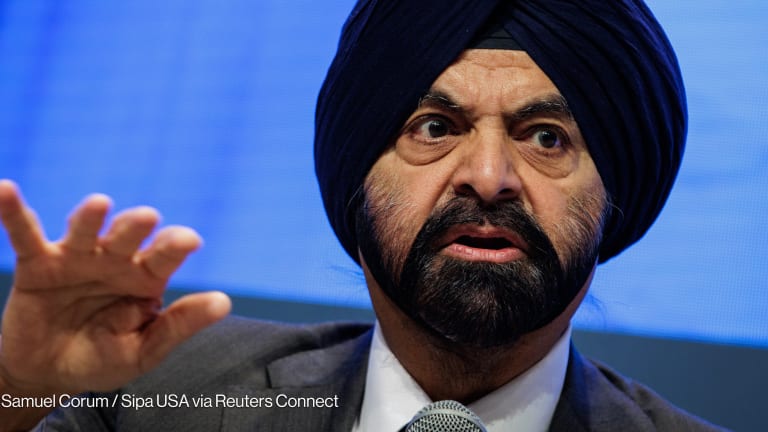
WASHINGTON — The World Bank is taking steps to move earlier into conflict-affected and fragile countries with more funding, more staff, and a mandate to focus on prevention, according to the institution’s fragility, conflict, and violence director.
As conflicts proliferate, with economic and social consequences that have grown more and more protracted for low- and middle-income countries, it has become increasingly difficult for the World Bank to fight poverty without also fighting the conflict that often drives it. By 2030, more than 60 percent of people in extreme poverty will be living in fragile states, according to the bank’s research.
See more coverage of the World Bank Spring Meetings:
► What to expect at the World Bank Spring Meetings
► Trump administration takes aim at World Bank salaries
► Concerns raised about World Bank support for private education
With those figures in mind the bank’s shareholders have set the international financial institution the task of moving into countries and contexts more often associated with humanitarian relief operations than with development investments. Last year’s 18th replenishment of the International Development Association, the bank’s fund for least-developed countries, doubled financing for fragile, conflict, and violence-affected countries.
“Focusing on fragile states has been a priority in the past, but we never received the mandate that was provided under IDA 18,” said Franck Bousquet, senior director of the World Bank Fragility, Conflict & Violence Group.
Devex spoke to Bousquet about how the bank has adapted its project planning, employee incentive structures, and partnerships to prepare for a greater focus on some of the world’s most difficult development challenges.
Here is our interview with Bousquet, edited for length and clarity.
What drove the decision to double financing for fragile states in IDA, and what made that increase possible?
The reason is very clear — poverty and fragility are extremely closely interlinked. What does that mean? It means that we are going to have between 43 percent and 60 percent of extreme poor that will be in fragile countries. So for the bank, when you look at eradication of poverty, if we don't focus on fragile countries we would be missing our target. For us it's the top priority, and that's why our shareholders, as part of the 18th replenishment of IDA, have allowed us to double the amount of financing available for FCV — fragile conflict and violence — countries moving from $7 billion to $14 billion over the next three years.
Fragility is not only a low-income problem — when we're talking about, for instance, Jordan, Lebanon, Iraq. That shows that fragility is not linked to the level of income, and we are also stepping in in terms of supporting those countries. So clearly, this amount of financing is key, but my key point is: This is not the whole picture. It's more about doing things differently. That is even more important. What does that mean? It means that we recognize the importance of this financing, so that it can be used to focus on the core drivers of fragility. Now, all our country partnership frameworks ... which basically guide our investment strategy in a country, are being informed by risk resilient assessments. Those assessments are the diagnostic tools that allow us to look at the prevention, to look at early warning, and to look at making sure that we are not going to come in once the crisis is [already] over.
More and more the bank will be looking at acting early and making sure that we can use our resources more effectively. You may have seen from the launch of the United Nations / World Bank prevention report that prevention makes sense, of course, because it saves lives, but also because it allows, economically speaking, to make significant savings — overall between $5 billion per year to about $70 billion depending on the scenario you are taking. We are making sure that when we support a fragile country under this IDA 18, $14 billion capacity that I mentioned, we are focusing on the drivers and the root cause of fragility.
The bank is a fundamentally analytical institution. How strong is the evidence base on drivers of conflict in these countries that you're talking about? Do you believe that with these diagnostic tools, the World Bank can actually predict, and therefore prevent, conflict through early development investment?
I think in this regard, yes. We have the risk resilient assessment, the diagnostic tools that, by the way, are also conducted in partnership with other key stakeholders. We, for instance, completed one in Tunisia, which is a middle-income country, with the French agency of development. We are working very closely with the EU partners, because they also bring in some comparative advantage, but also other partners among the G-7. We are doing that precisely to identify what are the grievances that, if they are not being solved today, could actually increase the probability of conflict. Look at the Central African Republic. I was in Bangui a month ago. [We are] looking at making sure that services are being provided across the country and not only in the capital, making sure that you're going to provide job opportunities for young people. This needs to be addressed by development at an early stage. Otherwise we know what could potentially happen and what has happened in the past. So I think yes, there is a key role to play.
“Where you have a crisis, humanitarian actors [respond], and then development actors come in just at a time of reconstruction. I think we are looking now at the bank being more and more present in FCV countries across the whole spectrum.”
— Franck Bousquet, senior director of the World Bank Fragility, Conflict & Violence GroupIs it new? It's new in the sense that we are really investing a lot in diagnostic tools, making sure that the strategies are actually building on those tools to focus on early action and on prevention, rather than coming in a more sequential manner — where you have a crisis, humanitarian actors [respond], and then development actors come in just at a time of reconstruction. I think we are looking now at the bank being more and more present in FCV countries across the whole spectrum. We are present in Yemen in the middle of a conflict, because we believe that it's not only a humanitarian crisis, but it's also a development crisis, and that if we are not strengthening service delivery — health, education, cash transfers — we may lose significant development gains.
And of course, we are present during the reconstruction. Let's not forget that the bank was created to focus on reconstruction and development. My home country [of France] was the first client. But what is important today is that we are not only focusing on the peace dividend, reconstruction, development, but looking earlier at how we can be partners with U.N. agencies. Partnership with the U.N. is at the highest level it has ever been. How can we work with security, humanitarian actors in the middle of a conflict and before. That's really moving the needle. My whole point to you is to say, yes the bank is scaling up, doubling its financing, but it's really to do things differently.
As focus moves more toward places that are difficult to work in and present security issues, are you hiring new people — and then also presumably retraining current staff to work in those contexts?
As part of the commitment to double resourcing the countries, going from $7 billion to $14 billion over the next three years, there were also other commitments, including to ensure that we have an additional 50 staff [in FCV countries] by last September, which we did, and an additional 150 staff by the end of the [three-year] period. So we are working closely with human resources to make sure that we meet these targets. We're completely on track. Why? Because we actually have, in terms of counterparts in many cases, low-capacity governments. That means a lot of hand holding. Also, because what we are looking at is actually working with other partners, and that requires a presence on the ground.
We take it so seriously — it's not only a question of staffing. It's a question of making sure that they belong to a community of practice, setting up intranet to make sure that the staff in the bank can have access to resources in the same way as a person in Sanaa [Yemen], making sure as well, in terms of reward incentives, that working in fragile countries counts for the career of staff. We are looking at all of what we call the ‘employee value proposition’ to ensure that focusing on FCV countries is not only a question of financing, but it's actually mobilizing the best people to work in those countries, and that's something big.
Who are you working with in the most fragile contexts, where there's not a ministry of health with access to vulnerable populations in rural areas, for example?
At the end of the day let's not forget, our clients are governments. They are the ones who are in charge of the financing. Financing is not being implemented through the bank. It's being implemented through the countries. So we are always working with government structures. In some cases, we realize that we also need to leverage other stakeholders — working with some U.N. agencies, working with NGOs in some cases to complement what can be offered by the government.
But I think it's very important — at the end of the day, it's like prevention. Who is accountable for it? It's the government. Who is in charge of making sure that they will be addressing the grievances and strengthening the social contract with the population to ensure that we act early and conflict does not escalate? The government. So I think it's very important to place the client countries in the driver's seat. We are development actors. We are here for the long period, in the worst and the best time, and we realize that. You don't want finance bypassing government, but instead supporting the capacity of government to address grievances and to be moving out of the fragility trap.
This is a shareholder-owned institution, and you've got shareholders with a wide range of views and interests. How is the bank confronting issues like human rights and exclusion and marginalization that, in a lot of cases, are the drivers of conflict? How do you confront those fundamentally political issues as an institution that's beholden to a lot of different political interests?
We are a development institution. We are not a political institution. In the end, our focus is boosting shared prosperity and eradicating poverty. So what we're looking at is how to leverage the comparative advantage of other institutions, which have a different mandate. Some of them are focusing on security, on areas where we are not in the driver's seat. [We are looking at] how we work with other partners, still focusing on our mandate, which is really eradication of poverty.








